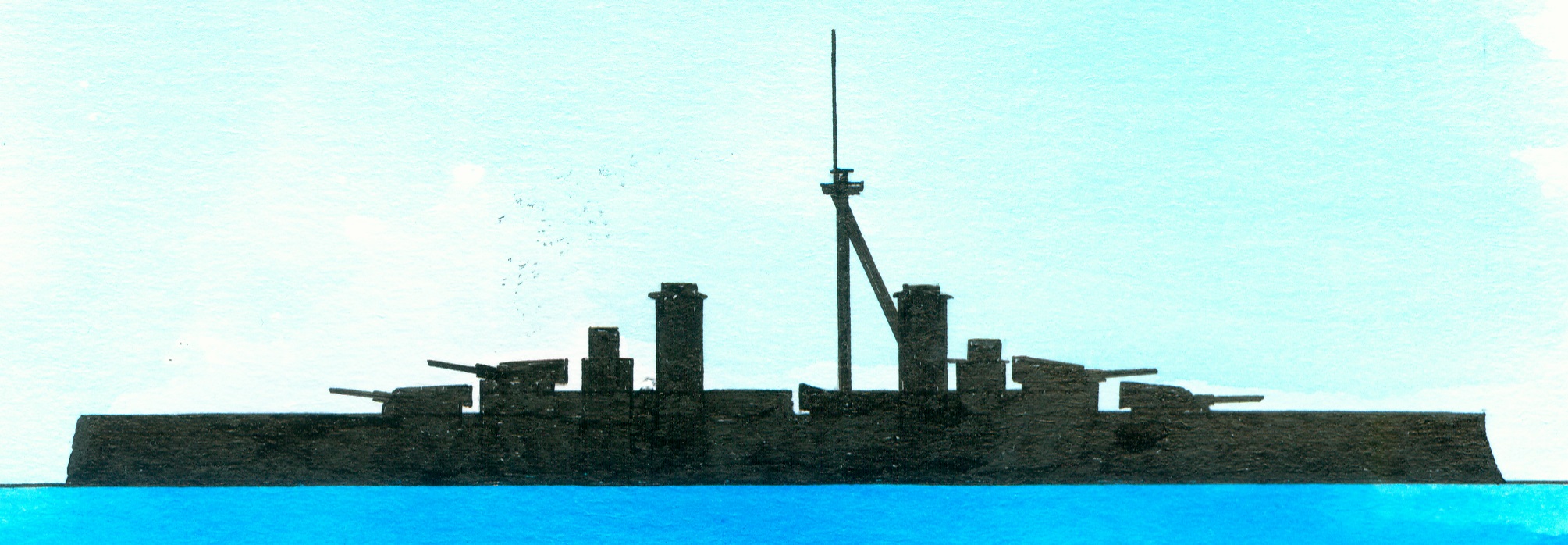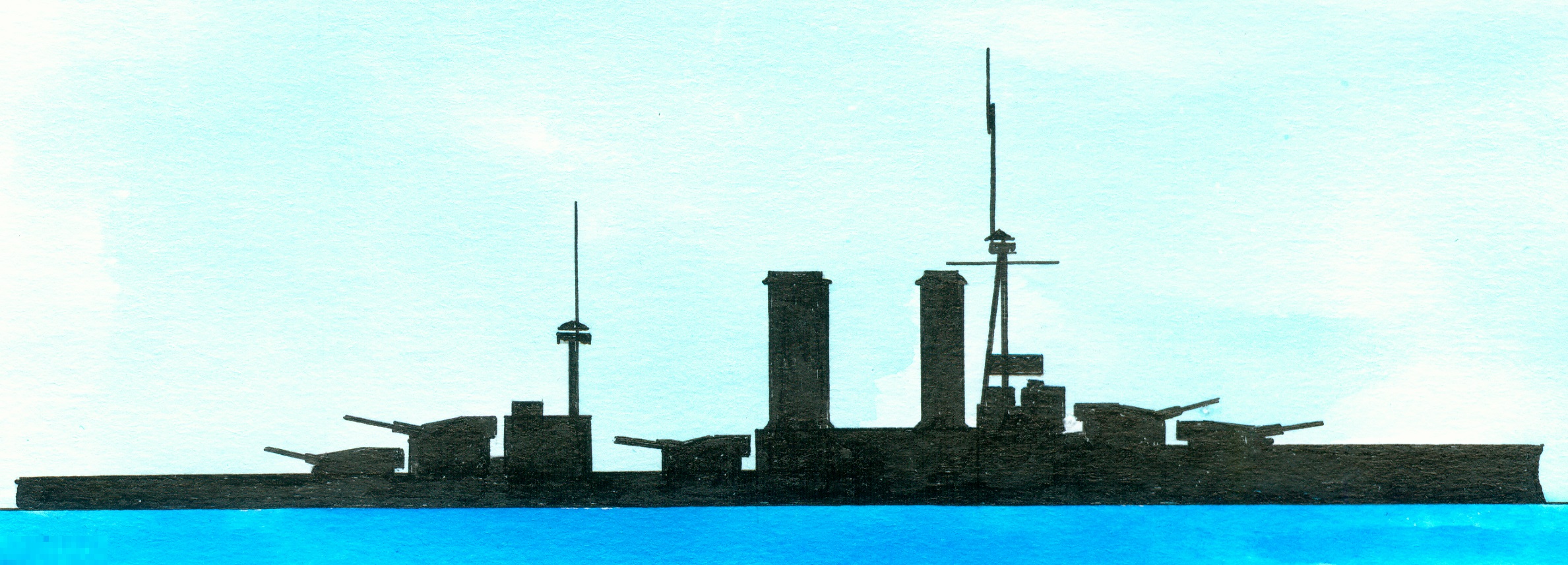Brazilian Minas Geraes-class
British Swiftsure-class
Argentinean Rivadavia-class
Chilean Almirante Latorre
Of the Minas Geraes-class consisting of the Minas Geraes and the Sao Paulo was built due toe the naval arms race between Brazil, Argentina (1) and Chile (2) . In the designing stages was first chosen to use the designs of the Norwegian coastal defence ship Norge (3) and the British Swiftsure (5)-class (originally designed for Chile), but later was the choice the Armstrong Whitworth’s Design 439 or Vickers Design 188 consisting of 12.000 tons battleships with a main armament of 6x2-1225cm/10” guns. The Design 439 was altered resulting in a 14.564 tons ship. There were 3 to be built but just when the actual building started ,was decided to stop and to break up starting on 7 January 1907. A new design was made by J.R. Perret (5) and which was approved on 20 February 1907 by Brazil. The third one ship of this class to be called Rio de Janeiro was cancelled and instead for which a super-dreadnought was to be built.
Laid down at Vickers, Barrow, England on 30 April 1907, launched and baptized by Mrs. Régis de Oliveira, on 19 April 1909, commissioned on 12 July 1910, refitted at New York, USA between 7 August 1918-7 January 1920, not modernized during to her worse condition in the 1930sserved as harbour defence ship during the Second World War, stricken on 2 August 1947, Training vessel until August 1951, sold to the Iron and Steel Corporation of Great Britain to be broken up and sunk when she was underway from Rio de Janeiro to the scrap yard at Greenock with her caretaker crew on board north of the Azores in early November 1951 without finding a trace of her back.
Technical specifications of her class. Displacement 19.105 (standard)-21.370 (full load) tons and as dimensions 150 (between perpendiculars)-166 (over all) x 25 x 7,53 (normal)-8,31 (full load) metres or 500-543 x 83 x 24.875-27.3 feet. The 2 shaft reciprocating vertical triple expansion steam engines and 18 Babcock&Wilcox boilers supplied 23.500 (shp, design)-23.400 (ihp design)-27.500 (ihp actual) allowing a speed of 21,5 knots. With a speed of 10 knots was her range 10.000 nautical miles. The armour consisted of a 7,6cm/3”-22,9cm/9” (upper deck), a 3,8cm/1.5” thick upper deck, a 5,1cm/2” thick main deck with the gun turrets, barbettes and conning tower protected by respectively 5,1cm/2”-7,6cm/3” roofs)-20cm/8” (sides)-30cm/12” (face), 23cm/9” and 5,1cm/2” (sides-roof)-30cm/12”. The original armament consisted of 6x2-30,48cm/12” guns, 22-12cm/4.7” guns and 8-3pd guns. During her modernisation in 1918-1920 were 18-12cm guns removed and replaced by some modern anti aircraft guns2-7,6cm/3” 50 cal guns and 3,7cm guns.
Notes
1. The Rivadavia-class battleships consisting of the Rivadavia and Moreno, designed by Fore River Shipbuilding Company, Quincy Point, USA, laid down in 1910
Displacement 27.900 (standard)-30.600 (full load) tons and as dimensions 178 (between perpendicular)-181,28 (over all) x 29,985 x 8,446 metres or 585-594.9 x 98,4½ x 27.8½ feet. Original armament 12-30,5cm/12” guns, 12-15,2cm/6” guns, 16-10,2c,/4” guns and 2-53,3cm/21” torpedo tubes.
2. The Almirante Latorre-class consisted of the Almirante Latorre and the Almirante Cochrane. Built in England were both ships taken over by the Royal British Navy, the Almirante Cochrane converted into the aircraft carrier HMS Eagle, the Almirante Latorre commissioned as the battleship HMS Canadaand sold back to Chile in 1920.
Displacement of 28.600 (standard)-32,120 tons and as dimensions 201 (over all) x 28 x 8,8 metres or 661 x 92 x 29 feet. Speed 22,75 knots. Armament 10-35,5cm/14” guns, 16-16,2cm/6” guns, 2-7,6mm/3” anti aircraft guns, 4-3pd guns and 4-53,3cm/21” submerged torpedo tubes.
3. Launched at Armstrong Whitworth, Newcastle on Tyne, England and destroyed by German destroyers in Narvik Harbour, Norway on 9 April 1940. Displacement 4.233 (standard) tons, dimensions 94,60 x 15,70 x 5,40 metres or 310.37 x 51.5 x 17.72 feet and a main armament of 2-21cm/8.26” guns.
4. Displacement 12.370 (normal)-14.060 (deep load) tons and as dimensions 144,9 (over all) x 21,7 x 8,3 (deep) metres or 475.3 x 71.1 x 27.4 feet and a main armament of 2x2-25,4cm/10” breech loading guns.
5. Josiah Richard Perrett (5 February 1848 Plymouth, England-1918), chief naval architect of Armstrong Whitworth, Elswick yard.






